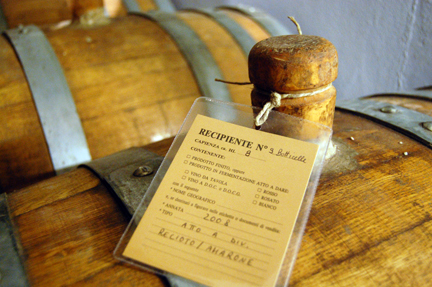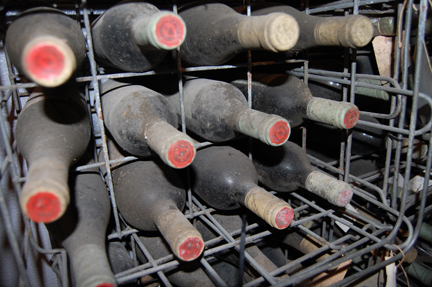
Except for the cover of Hemingway’s novel below, all the images here were captured when we tasted at the winery in January 2011.
 In 1949, as he lay dying (or convinced that he was about to die as the result of hunting accident) in Venice, Ernest Hemingway famously drank Valpolicella. His brush with death and his love of the wines of the Valpolicella are fictionalized in Across the River and into the Trees (Scribner 1950), a novel he thought would be his last. The main character, Colonel Cantwell (a lightly veiled autobiographical figure), always seems to have a bottle of Valpolicella at hand’s reach, even though the Colonel believes “that the Valpolicella is better when it is newer. It is not a grand vin and bottling it and putting years on it only adds sediment.”
In 1949, as he lay dying (or convinced that he was about to die as the result of hunting accident) in Venice, Ernest Hemingway famously drank Valpolicella. His brush with death and his love of the wines of the Valpolicella are fictionalized in Across the River and into the Trees (Scribner 1950), a novel he thought would be his last. The main character, Colonel Cantwell (a lightly veiled autobiographical figure), always seems to have a bottle of Valpolicella at hand’s reach, even though the Colonel believes “that the Valpolicella is better when it is newer. It is not a grand vin and bottling it and putting years on it only adds sediment.”
Some 25 years later, in the landmark Vino al Vino, the great Italian wine writer Mario Soldati reluctantly called Quintarelli’s wine the “closest” to the wine that Hemingway loved, adding “I’m not saying it’s the best Valpolicella on the market” (Soldati’s preferred “artisanal” Valpolicella — yes, artisanal, that’s the term he used in 1975 — was Galtarossa).
Both texts open a window onto how Valpolicella and its wines were perceived in the post-war era — in Italy and abroad (in his 1950 review of Hemingway’s novel in The New Yorker, Alfred Kazin wrote, paraphrasing the novelist, that “Valpolicella is better poured from flasks than from bottles; it gets too dreggy in bottles”).

Giuseppe “Bepi” Quintarelli — the son of the man who made the wines that Soldati tasted — was born on March 16 19, 1927 and died yesterday at home in Negrar after succumbing to a long battle with Parkinson’s disease.* It wasn’t until the 1980s that he began to experiment in his family’s vineyards and cellar, ultimately creating some of the world’s most coveted, collected, and expensive wines.
“Bepi was a deeply religious man,” said winemaker Luca Fedrigo, 33, who spoke to me early this morning from Santa Maria di Negrar in the Valpolicella. Luca worked side-by-side with the maestro for 10 years, from age 17 to 27, from 1992 until 2002.
“All of his vacations were religious [in nature]: Rome to see pope Pius XII; Lourdes; and the Holy Land. But in the 1980s he also made a trip to Burgundy, where he discovered that the soils there were similar to the [Morainic] soils of the Valpolicella. That’s when he began to believe that we could make great wines here.”
“He was self-taught,” said Luca, “He learned early on that the priest of the village and the bishop of Verona were willing to pay well for quality wines. Priests always like the finest things in life. He was always experimenting, in the vineyard and the cellar, constantly looking for ways to make better wines.”
Leafing through the many tomes on Italian wine that inhabit our shelves at home, I discovered that Anderson (Vino, 1980) and Wasserman (Italy’s Noble Red Wines, 1985) both parsimoniously cite Quintarelli as one of the best “traditional” producers but do not give him the praise that Belfrage would later bestow in 1999 in Barolo to Valpolicella.

“One realizes in his presence,” wrote Belfrage, “as he draws samples from this barrel and that, intently studying your expression and your words as you taste and comment, that it is this attention to every detail which constitutes the difference between the great and the good in artisanal winemaking.” (Note the quasi-apologetic use of artisanal.)
Today, Quintarelli’s Amarone and Recioto, as well as half bottles of his rare white Amabile “Bandito”, command upward of $300 a bottle retail in the U.S.

In Negrar, Quintarelli was no mere artisan but rather a maestro and a patron saint and protector.
“Bepi departed with the same discretion with which he lived,” said Luca.
“He was one of the most generous persons in Valpolicella,” he recounted. “His gave generously to help children in Africa and he never hesitated to help people from the village who needed help. And he was always happy to share the secrets of his winemaking. For him, there were no secrets.”
Luca, who at Bepi’s encouragement launched his own winery some years ago and continues to make wines in the same style, was one of Bepi’s students. The other was Romano Dal Forno, considered by many the father of modern-style Valpolicella.
“Whatever the style, Bepi taught us how to reach for quality in winemaking. And as generous as he was, he could also be severe” in his criticism. “We both learned from him.”
“I think of him as the nonno dell’Amarone,” the grandfather of Amarone. “When [his daughter] Silvana called me yesterday to tell me that he had passed way, I had a long cry. I couldn’t help it,” said Luca, whose emotion was palpable over the intercontinental connection.
It’s been amazing to see the internet reaction to Quintarelli’s passing. Knowing the focus, beauty, and spiritual clarity that Bepi sought in his life on earth (and in his wines as an expression of that earth), it’s not surprising…

I was introduced to these wines in the summer of 2000. From there I always hoped I would meet Sig. Quintarelli as my fascination with his style was eclipsed by my curiosity of his personality. I know some folks who are very close to him and my thoughts go out to them today.
Beautiful writing and research Jeremy. Moving indeed.
I had the privilege of meeting Quintarelli back in 2005 on my honeymoon in Italy, of course only because I was working in the Central Market land at the time. My husband and I got hooked up with Luca, as L’Arco wines had just hit CM shelves…During our 2-minute conversation Quintarelli saw right thorough me, and called me “furba” :-)
P.S. Hi Jeremy, I am a friend of Michael Housewright’s from his Austin days. Cheers!
Natasha @ Come Due Maiali
Pingback: Giuseppe Quintarelli: Maestro of the Veneto | the (z)infidel
I’m deeply honored to have tasted several of Mr. Quintarelli’s Amarone and Recioto, and have since stored several bottles, beginning with his incredible 1995 Amarone Riserva. I sincerely hope somebody picks up his mantle.
I was so fortunate, thru a conoscente, to have enjoyed a bottle of Sig. Quintarelli’s exquisite Amarone in the late 1970’s. An exceptional wine which I have yet to find anything comparable. Le nostre preghiere e auguri alla sua famiglia.
Pingback: Decanter messes up « Polish Wine Guide
Pingback: Quintarelli effect & a secret of Ripasso revealed (Nicola Ferrari’s Monte Santoccio) « Do Bianchi